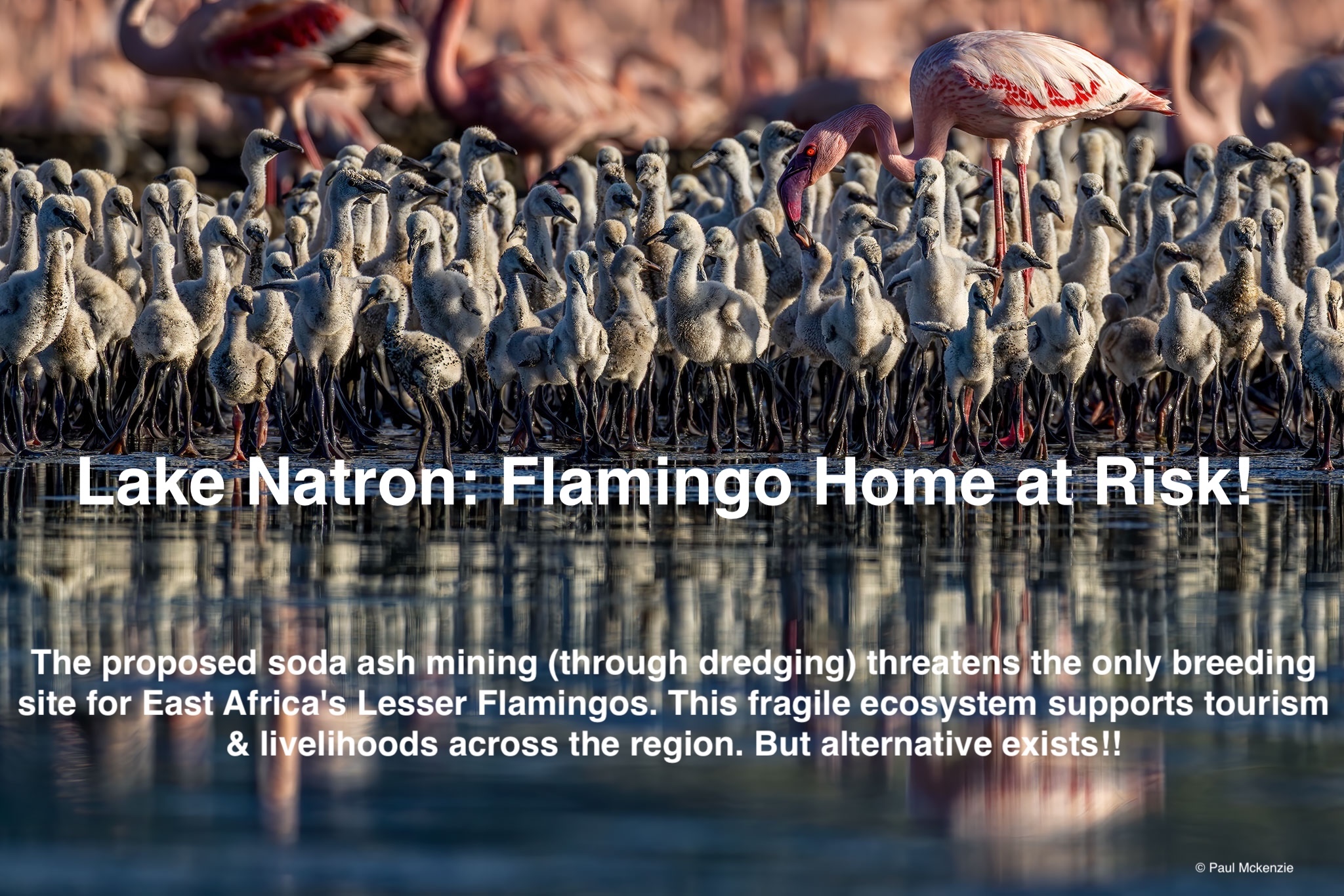By Akshita Rabdiya, Nature Tanzania
Under the blinding sun, with temperatures soaring past 42°C, and in the face of torrential rains and high-altitude winds that sweep across the East African Rift Valley, our team continues its daily vigil at the surreal expanse of Lake Natron. For Akshita Rabdiya, who is also a PhD student at the University of Dar es Salaam, it is more than work—it is a commitment to safeguard one of the world’s most unique ecosystems and its most iconic resident: the Lesser Flamingo.

An adult Lesser Flamingo tends to its chick within a large creche of the youngsters in the shallow waters of south west Lake Natron, Tanzania (Picture Credits: Paul Mckenzie)
Lake Natron, a Ramsar site and East Africa’s only regular breeding ground for the Lesser Flamingo, holds a global responsibility. This lake supports up to 75% of the world’s Lesser Flamingo population, whose alkaline waters—inhospitable to most lifeforms—nurture the cyanobacteria and algae that constitute the primary food source for Lesser Flamingos. This year, the lake also supported the successful breeding of Greater Flamingos. From January 2024 to June 2025, our work has been centred around the intensive monitoring of these flamingos and other waterbird species. Every day, from dawn at 6:00 AM until dusk at 6:00 PM, we observe and record flamingo behaviour, breeding activity, feeding patterns, and movement. Simultaneously, we measure a range of water quality parameters, including salinity, temperature, pH, dissolved oxygen, and water depth. These data points are critical in helping us understand how climatic shifts and hydrological changes affect the lake and its dependent biodiversity.
But this year, Lake Natron defied both expectations and historical norms. Despite an exceptional rainy season that brought heavy downpours between March and May, over 25,000 Lesser Flamingos initiated breeding. Egg-laying began in late February, and incubation stretched into early April, perfectly overlapping with Tanzania’s peak rainy season. By mid-March, the first rains began falling over the Natron basin. Within weeks, the lake was transformed—its margins swelled, ephemeral channels coursed across the salt flats, and shallow nesting grounds began to flood.

Lesser Flamingo incubating their eggs at Lake Natron (Picture Credits: Akshita Rabdiya)
As researchers, we were hopeful yet cautious. Flamingos build conical nest mounds from lakebed mud, elevated just high enough to protect their precious eggs from minor water level fluctuations. But this year, rainfall was persistent and aggressive. In early April, a week of uninterrupted storms swept across the region. The mounds, unable to withstand such inundation, began collapsing. Eggs were washed away. Chicks that had only recently hatched struggled against the cold, wind, and rising waters. Many didn’t make it.

Remains of lesser flamingo chicks, after heavy rain at Lake Natron (Picture Credits: Akshita Rabdiya)
When the storms subsided and we resumed our surveys, the aftermath was sobering. Of the thousands of eggs laid, only about 45% hatched successfully and produced surviving chicks. It was a reminder of the delicate balance flamingos must maintain in such a harsh, volatile environment—and the increasing role climate variability plays in influencing their breeding success.
Yet, even in this adversity, there were remarkable stories of resilience.
We observed several adult flamingos attempting to rebuild nests after the floods. In some areas, colonies shifted slightly to higher grounds. Adult birds stood guard over surviving chicks for days on end, shielding them from both predators and the elements. It was a raw, emotional insight into the parental investment of a species often seen only as a pink silhouette on a distant salt flat.
Alongside our breeding monitoring, we also continued waterbird counts and biodiversity assessments. Lake Natron, despite its extreme chemistry, supports a variety of avian life—Black-winged Stilts, Pied Avocets, Chestnut-banded Plovers, and Pink-backed Pelicans, among others. Many of these birds also respond dynamically to rainfall and changing lake levels. Our goal is to capture these patterns over the years and better understand how Natron functions as a seasonal refuge and breeding site for multiple species.

Akshita Rabdiya collecting important data and information on one of the abandoned nests of the Lesser Flamingo at Lake Natron. (Picture Credits: Paul Mckenzie)
This long-term monitoring project also provides critical evidence for conservation planning. With increasing pressure from development, climate change, and unregulated tourism, Lake Natron’s fragile ecosystem needs more than just occasional attention—it needs consistent data, community engagement, and policy advocacy. Through our partnerships with BirdLife International and The Rufford Foundation, we are working to bridge science and conservation on the ground. We also work with local communities, training youth in ecological monitoring and raising awareness of the unique value that Natron holds.

Field Guide training by Akshita Rabdiya at Engare Sero village of Lake Natron. (Photo Credits: Emmanuel Mgimwa)
Our work continues through mud, heat, storms, and silence. Each day brings new challenges, but also new insights into the incredible adaptability and vulnerability of the flamingos. In witnessing both the triumphs and tragedies of their breeding season, we are reminded why this lake matters—not just to Tanzania or Africa, but to the world.
As climate extremes become more frequent, the future of Lake Natron and its flamingos remains uncertain. But through science, commitment, and collaboration, we hope to secure a future where flamingos can continue to dance across the salt plains of Natron—undaunted by the storm, resilient against the flood, and celebrated by those who stand guard for them.


